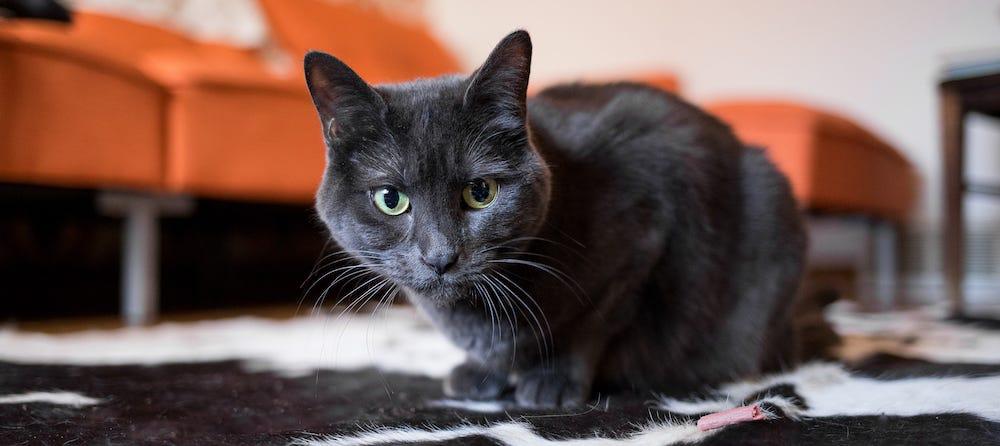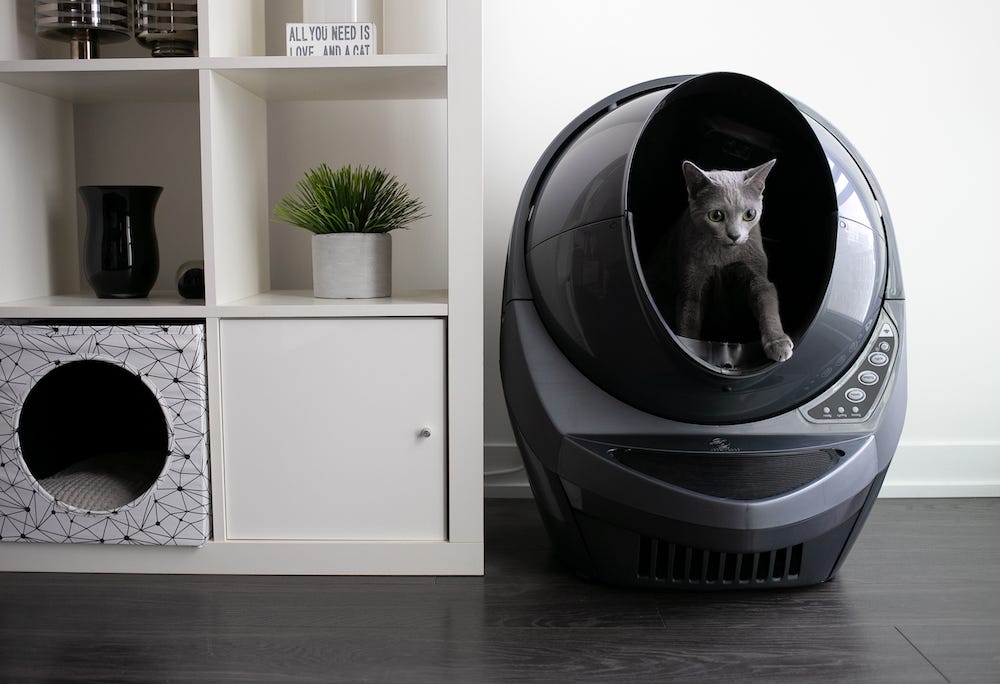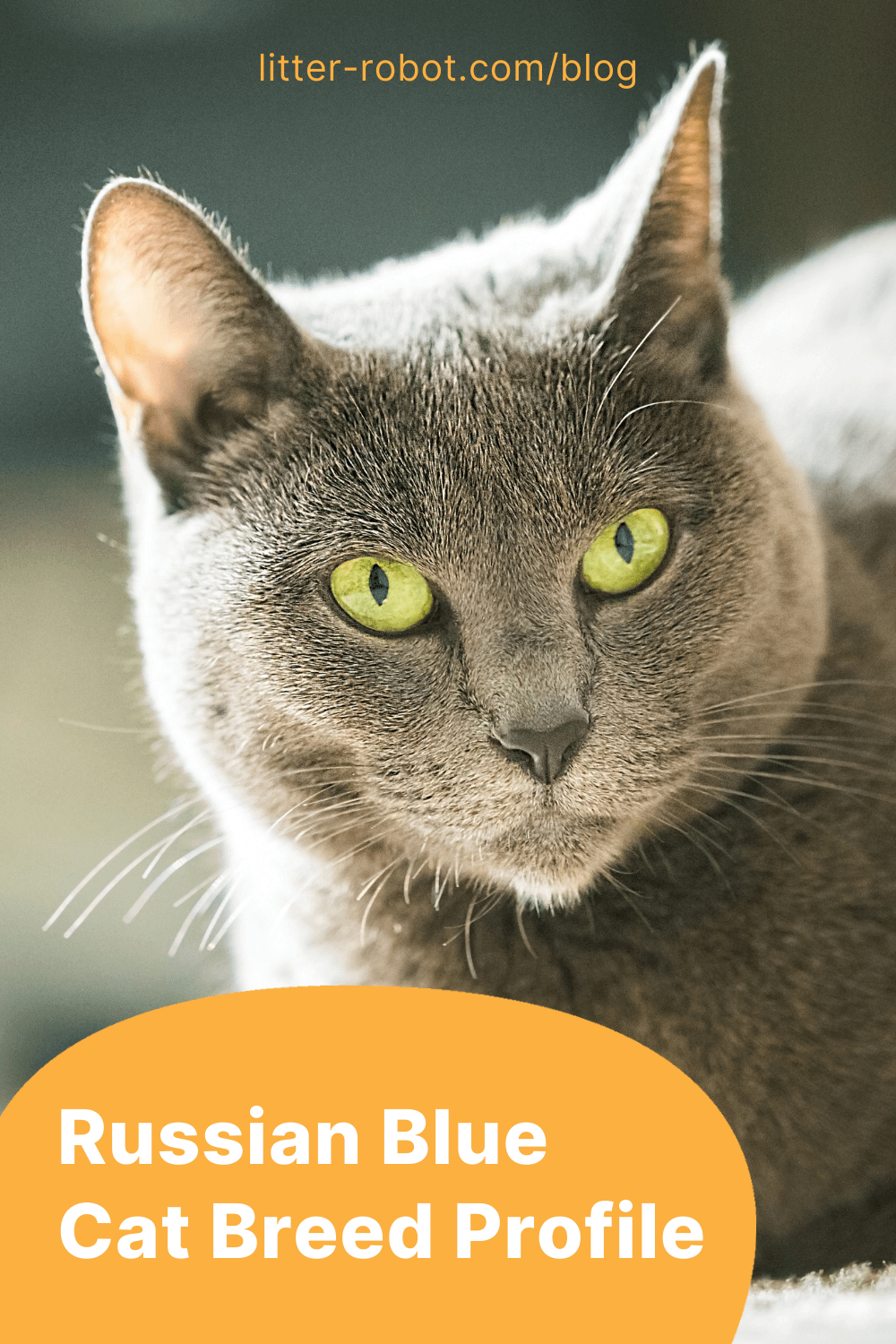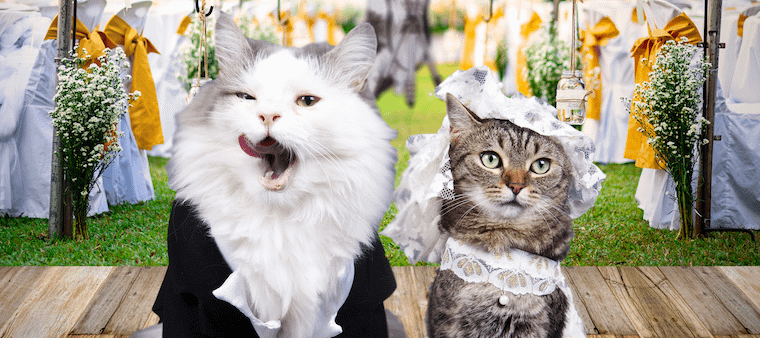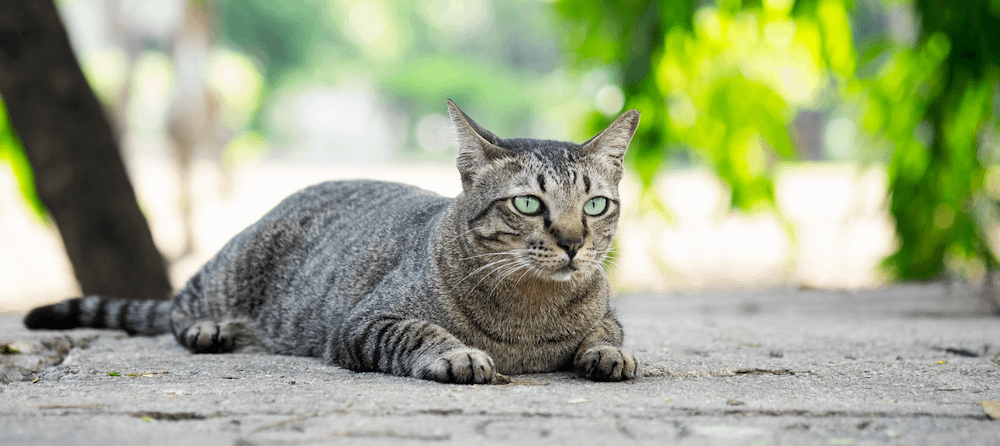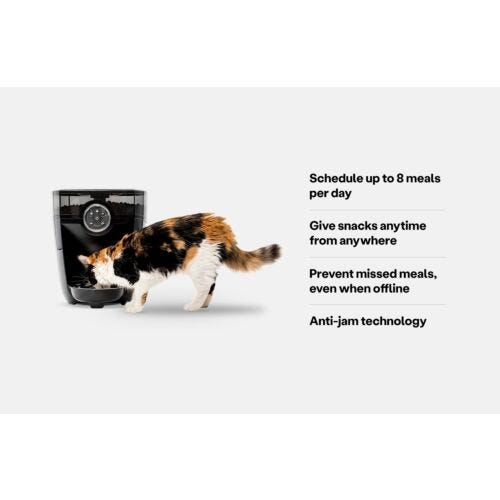When you combine striking green eyes, a luscious blue coat, and a loving yet shy personality, you get the Russian Blue cat. These elegant felines are great family-friendly cats that will wow strangers with their unique look. You might look at these cool cats and wonder if they are judging you. (And you might be right!)
The Russian Blue cat is playful, loving, and loyal. They want to be with their family but are happy to spend time alone. These cats do enjoy their independence, but they can be affectionate and energetic when they feel comfortable.
The Russian Blue is a great pet to care for if you are looking to adopt your first cat. They are typically low-maintenance and adapt easily to changing environments, making them ideal for people who live in apartments.
| Russian Blue cat | ...at a glance |
|---|---|
| Personality | Loyal, playful, independent |
| Life expectancy | 12-20 years |
| Weight | 6-12 lbs |
| Coat & colors | Short, dense; blue |
| Energy level | Medium |
| Affection level | High |
| Friendliness | Medium |
| Shedding level | Low |
| Required grooming | Low |
Overview of a Russian Blue cat
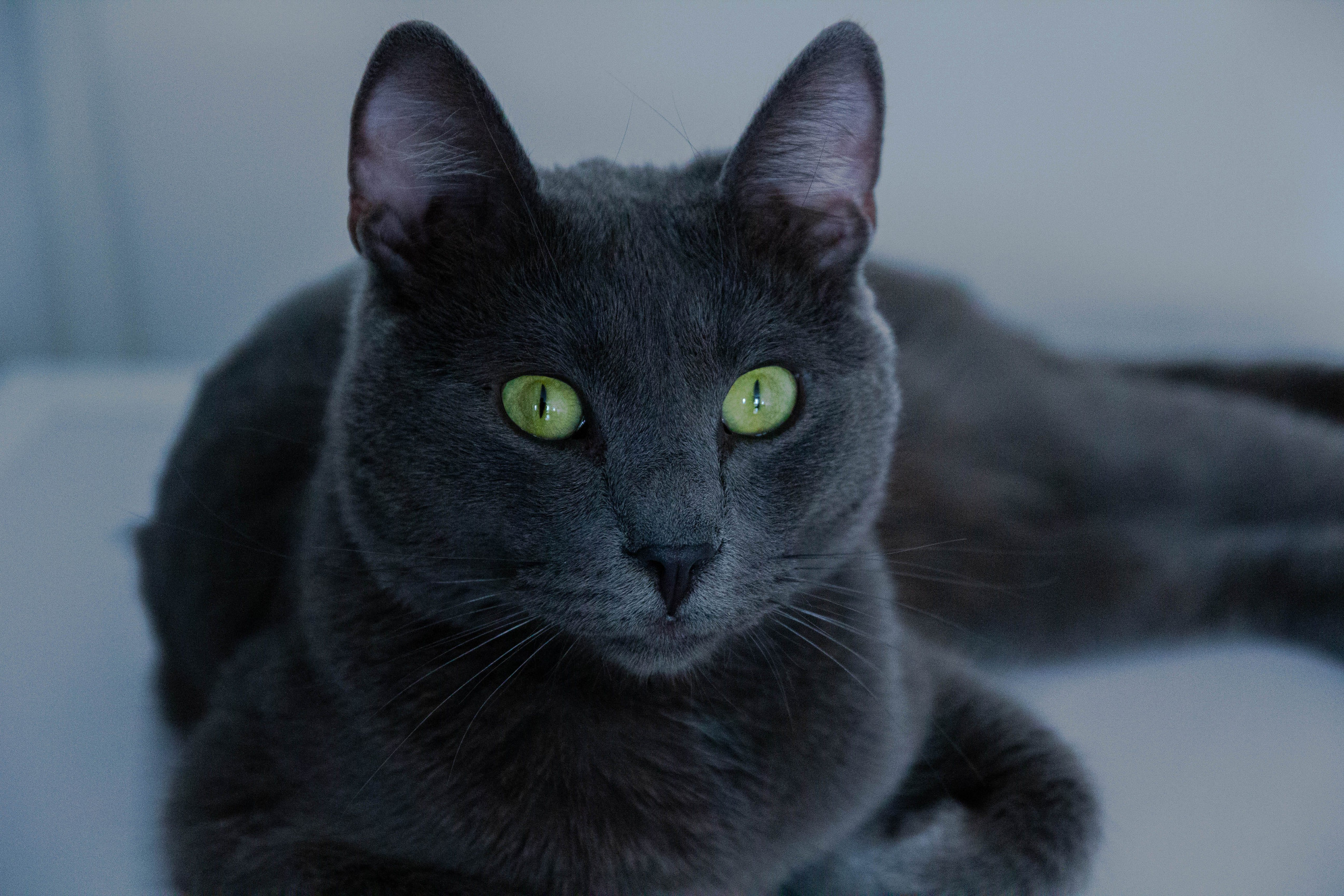
The Russian Blue is a small- to medium-sized cat that is extremely recognizable. They have a shimmery bluish-grey coat with stunning green eyes. They are both independent and loving, giving them a dynamic that’s perfect for first-time pet parents.
Weight
Russian Blues typically weigh between 6 and 12 pounds, with females averaging slightly smaller than males. They are fine-boned with a slim frame that is graceful and flexible. They move quickly and quietly.
Length
Russian Blue cats are long and slender felines. From nose to tail tip, they can be up to 24 inches long (yes, 2 whole feet) and 10 inches tall. This gives them a very slinky appearance, and if you catch them moving out of the corner of your eye, you might think you’re seeing shadows in motion.
Coat
Their short, plush double coat is arguably one of the most defining features of the Russian Blue.
The undercoat is soft and dense, which helps provide insulation against cold weather. The guard hairs of the overcoat sport silver tips that give their coat a shimmering appearance. These coats were made to withstand harsh winters and difficult weather, so they can adapt to many environments.
Eye Color
Vivid green eyes are the other distinctive feature of the Russian Blue. Kittens are born with bright blue eyes; over the first few months of life, their eye color changes from blue to golden yellow, and finishes off as green. While these colors are relatively short-lived, it’s entrancing to watch the change unfold.
Lifespan
Russian Blues were able to withstand centuries of harsh winters in Northern Russia, so they can certainly adapt to outdoor living. But now that they’ve found their way to safe, warm homes, they are here to stay and strongly prefer the safety and comfort of indoor life. And for many years with you, they will!
The indoor lifestyle helps contribute to their longevity. A healthy and well-cared-for Russian Blue cat can live for 15 years or more. With good exercise, proper nutrition, and lots of affection (and annual vet visits), your Russian Blue can be around for the long haul.
History of the Russian Blue cat
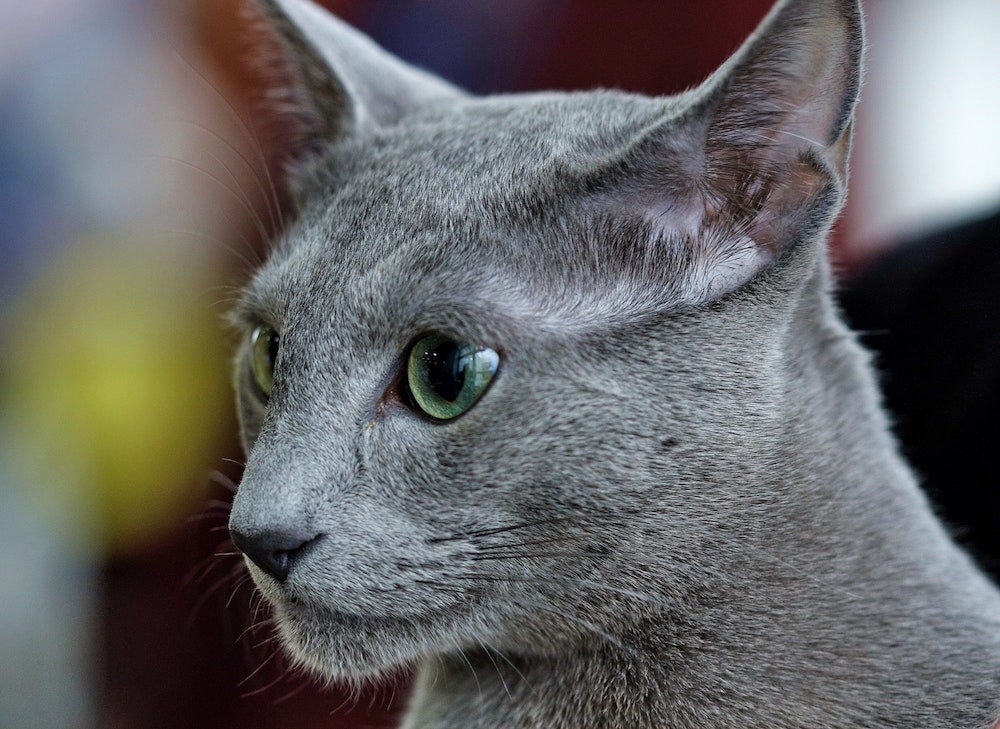
No one is exactly sure where the Russian Blue cat originated, but there are some theories floating about. The most prominent one is that they sailed to Great Britain on ships with the British from the Russian White Sea port town of Archangel Isles, or Arkhangelsk, in the 1800s.
There are many accounts that claim blue shorthair cats are a naturally occurring breed and not a product of breeder intervention in Russia. This theory is widely accepted because their dense, plush coats do well in the harsh weather of Russia and Northern Europe.
Originally, the Russian Blue was presented as the Archangel cat at the Crystal Palace cat show in London, England. In the 1880s, the Russian Blue competed as a shorthair cat, even though there were distinct differences in other shorthair cat coats. They rarely won in their first cat shows, as round and plump cats were all the rage at the time. Still, they persevered.
Like other cats, the Russian Blue almost met their fate during World War II. It wasn’t until they came to the United States in the early 1900s that breeders began to uphold and promote the breed. Now, they are well-loved by many families and are recognized in all North American cat associations.
Characteristics
The Russian Blue is tall, long, and slender. They have a long tail that is similar in length to their body. Their legs are also long but rather thin, with small paws. This helps make them nimble and quick during playtime.
They are often mistaken for the Korat, the Chartreux, and the British Shorthair, but make no mistake—they are very much their own breed.
They have bright, wide-set eyes, with slightly pointed ears set far apart on their head. The Russian Blue is attentive and careful. They will likely be alert to what you are doing at any given point of the day.
Are Russian Blue cats hypoallergenic?
While no cats are truly hypoallergenic, Russian Blues are considered one of the less allergenic cat breeds available. If you struggle with cat allergies, but aren’t bothered by minimal allergic reactions or are willing to take allergy medicine more often than not—the Russian Blue should be on your list.
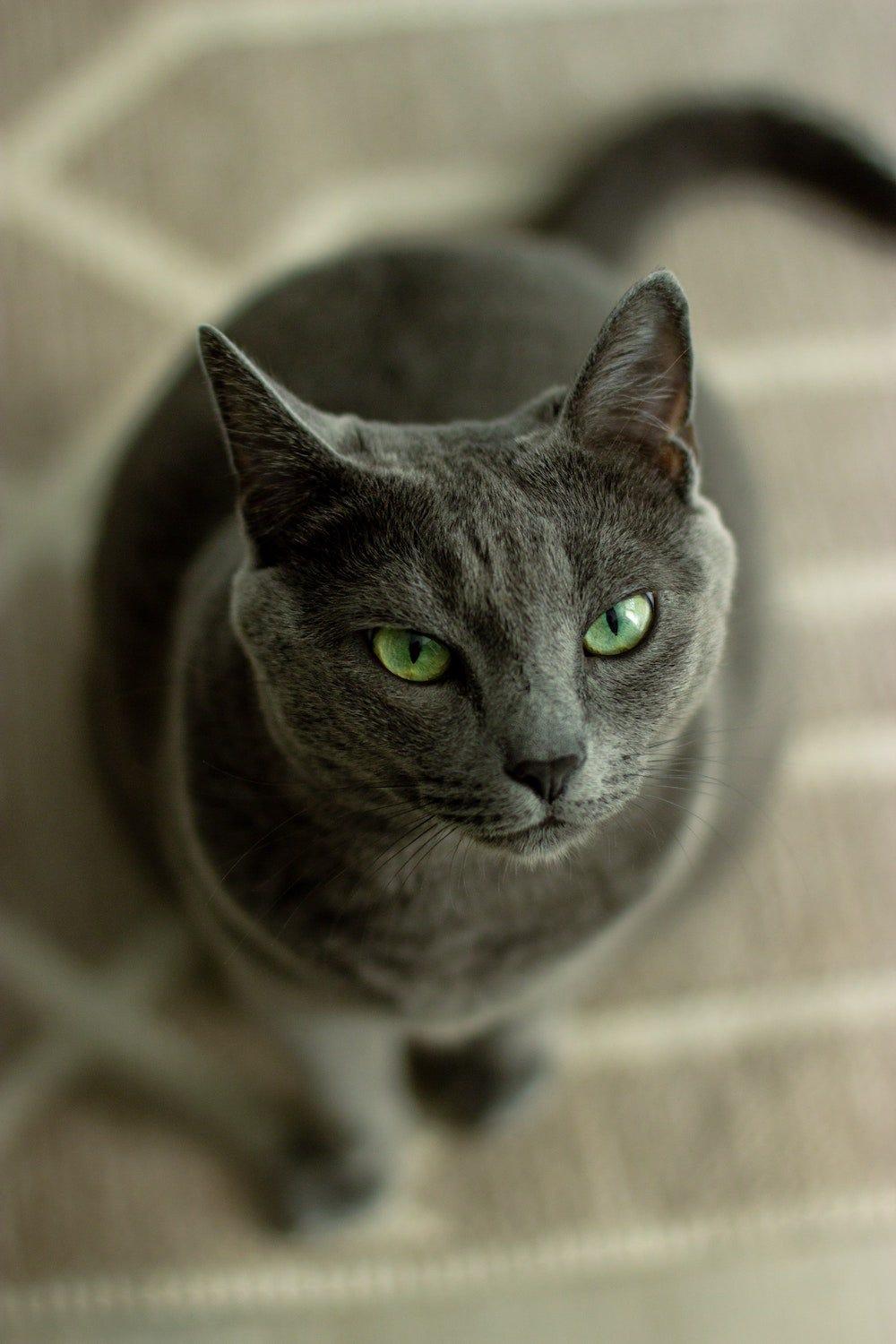
Personality traits
If you’re looking for a gentle and playful cat that doesn’t mind being cuddled but values their independence, this is the kitty for you. The Russian Blue is loyal to their family but somewhat shy around strangers. They have a playful energy and can tolerate other animals and children.
Russian Blues might not be the first cat to jump onto a random visitor’s lap, but that doesn’t mean they won’t be happy to cuddle up next to their trusted humans. If you’re home, they may follow you around. If you leave, they will find ways to entertain themselves. Luckily, these cats don’t get overly lonely when their humans are gone.
It’s important to keep in mind that Russian Blues are sensitive to sudden changes in their environment. They can also show some signs of stress or behavioral issues if they’re not provided with enough mental stimulation. Consistency in their routine and a variety of interactive toys are key to keeping them happy and engaged. Your Russian Blue will want to play often, especially if you’re involved in the playing. They could chase a toy around for hours if their human was the one pulling the string!
Caring for this breed of cat
Russian Blues are very particular about cleanliness, which extends to their litter habits. They may refuse to use a litter box that isn't up to their standards. Ensuring their environment is both clean and stimulating is important to prevent any potential behavioral issues.
Taking care of your Russian Blue should be no problem, even if you are a first-time cat parent. They are very dependent on keeping to a familiar schedule and dislike changes in the daily routine. They will let you know when it’s time to nap and if you’re late to their mealtimes.
Having plenty of toys and stimulating games can keep your highly intelligent Russian Blue occupied.
Russian Blues also require a top-notch litter box, and if it’s not up to their standards, they won’t use it. If this is the case with your Russian Blue and you aren’t able to clean the litter box after every use, consider using Litter-Robot. This automatic, self-cleaning litter box provides your Russian Blue a clean bed of litter every time, which means they can use the bathroom without leaving dirty tracks throughout your house.
Grooming needs
Russian Blues appreciate regular brushing to keep their coat at its best, reflecting their overall need for cleanliness. Grooming your Russian Blue will be a low-maintenance task. They have short, dense coats that only need weekly grooming to collect loose fur. They will need their nails trimmed regularly, as well.
Possible health issues
With a lifespan of 15+ years, you can assume your Russian Blue will be a happy and healthy individual. There aren’t any known genetically linked disorders for the Russian Blue.
However, they can develop progressive retinal atrophy (PRA), which deteriorates photoreceptor cells and can lead to blindness. They are also prone to UTIs and bladder stones. Be sure to take your Russian Blue to the vet at least annually for check-ups.
Additionally, you should watch your Russian Blue’s weight because obesity can be an issue. The Russian Blue is a laid-back indoor cat that prefers being treated as a Russian czar, so too many treats and prolonged inactivity can prove harmful. Healthy cat food and plenty of playing is a great way to support your Russian Blue and minimize any potential health problems.
The cost of a Russian Blue cat
The cost of a Russian Blue cat can vary significantly, primarily depending on whether you choose to purchase from a breeder or adopt from a rescue.
When purchasing from a reputable breeder, you can typically expect to pay between $400 and $600. The price can even escalate up to $2,000 for purebred, show-quality cats.
On the other hand, adopting a Russian Blue from a rescue or shelter can be a more affordable option, with costs usually ranging from $75 to $150. This cost often includes initial veterinary care such as vaccinations, microchipping, and spaying or neutering. Not only can adoption be more cost-effective, but it also provides a loving home for a cat in need—especially for older cats that still have plenty of love to give.
However, it's important to remember that the upfront cost of acquiring the cat is just the beginning. Having a cat comes with ongoing expenses that should be factored into your budget. These include the cost of high-quality cat food, litter, toys to keep your Russian Blue mentally stimulated, grooming supplies to maintain their beautiful coat, and regular vet checkups to ensure their health. Despite these costs, the joy and companionship that a Russian Blue cat brings to a family are priceless. Their loyalty, playful energy, and stunning looks make them a wonderful addition to any home.
Adopting a Russian Blue
The Russian Blue is genuinely an ideal cat to call a family member, whether you are new to cats or have loved them for years and years. They provide their families with unconditional love, loyalty, and memories. They will become your best friend and want to spend unlimited time with you and your loved ones.
If you can provide ample playtime, proper nutrition, a clean litter box, plenty of toys, and lots and lots of love, a Russian Blue will be happy in your home. They are a great kitty with a lot to offer to those who earn their respect.
Sources:
- Russian Blue | Breed Of Cat | Britannica
- An Update On Molecular Cat Allergens: Fel d 1 And What Else? Chapter 1 | NCBI
- Progressive Retinal Atrophy In The Cat | VCA Animal Hospitals
Photo credits:
- Simion Andreea-Marina via Unsplash
- Sergey Semin via Unsplash
- Fancy Boy Jasper
